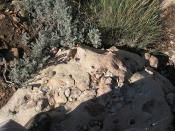Fossil fuels are hydrocarbons formed from the remains of dead plants and animals. The theory that hydrocarbons were formed from these remains was first introduced by Mikhail Lomonosov in 1757. In common dialogue, the term fossil fuel also includes hydrocarbon-containing natural resources that are not derived from animal or plant sources. These are sometimes known instead as mineral fuels. The utilization of fossil fuels has enabled large-scale industrial development and largely supplanted water-driven mills, as well as the combustion of wood or peat for heat.
Fossil fuel is a general term for buried combustible geologic deposits of organic materials, formed from decayed plants and animals that have been converted to crude oil, coal, natural gas, or heavy oils by exposure to heat and pressure in the earth's crust over hundreds of millions of years.
When generating electricity, energy from the combustion of fossil fuels is often used to power a turbine.
Older generators often used steam generated by the burning of the fuel to turn the turbine, but in newer power plants the gases produced by burning of the fuel turn a gas turbine directly.
With global modernization in the 20th and 21st centuries, the thirst for energy from fossil fuels, especially gasoline derived from oil, is one of the causes of major regional and global conflicts. A global movement toward the generation of renewable energy is therefore underway to help meet the increased global energy needs.
The burning of fossil fuels by humans is the largest source of emissions of carbon dioxide, which is one of the greenhouse gases that allows radiative forcing and contributes to global warming. A small portion of hydrocarbon-based fuels are biofuels derived from atmospheric carbon dioxide, and thus do not increase the net amount of carbon dioxide in the atmosphere.




